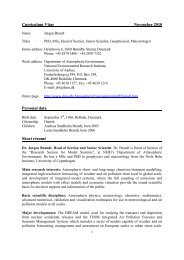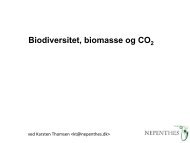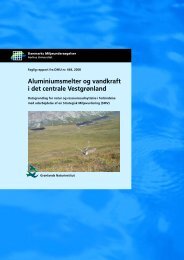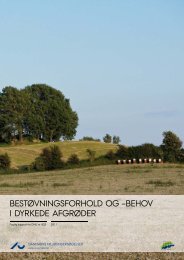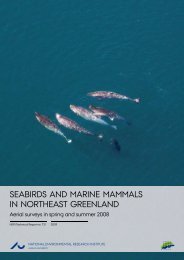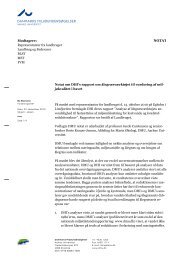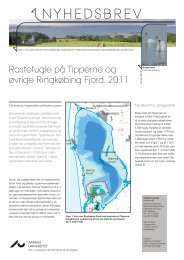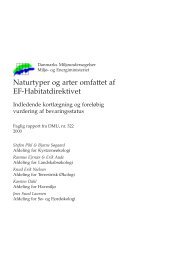Spatial distribution of emissions to air - the SPREAD model
Spatial distribution of emissions to air - the SPREAD model
Spatial distribution of emissions to air - the SPREAD model
You also want an ePaper? Increase the reach of your titles
YUMPU automatically turns print PDFs into web optimized ePapers that Google loves.
12<br />
A number <strong>of</strong> plants are treated as Large Point Sources (LPS) in <strong>the</strong> Danish<br />
emission database. The LPSs are characterised by having more detailed<br />
data on fuel consumption, emission fac<strong>to</strong>rs and/or <strong>emissions</strong>, as<br />
plant, installation or process specific data. Emissions from all LPSs are<br />
treated in <strong>the</strong> Large Point Source sub-<strong>model</strong> in <strong>SPREAD</strong>. LPSs represent<br />
<strong>emissions</strong> at all SNAP 1 categories except road traffic (SNAP 07). LPSs in<br />
agriculture (SNAP 10) are included in a separate part <strong>of</strong> <strong>the</strong> emission database<br />
system covering agriculture and are not included in <strong>the</strong> LPS sub<strong>model</strong><br />
in <strong>SPREAD</strong>. The Point Sources sub-<strong>model</strong> covers <strong>emissions</strong> from<br />
stationary combustion from point sources, which refer <strong>to</strong> <strong>the</strong> large number<br />
<strong>of</strong> plants for which <strong>the</strong> fuel consumption is known at plant level but<br />
<strong>emissions</strong> are calculated due <strong>to</strong> standard emission fac<strong>to</strong>rs.<br />
A spatial <strong>distribution</strong> is more relevant for some pollutants, e.g. particulate<br />
matter as <strong>the</strong>y can cause health effects in <strong>the</strong> vicinity <strong>of</strong> <strong>the</strong> emission<br />
site. O<strong>the</strong>r pollutants like <strong>the</strong> greenhouse gasses have no or little health<br />
effect but are more relevant regarding large-scale conditions such as climate<br />
change and global warming. Never<strong>the</strong>less <strong>SPREAD</strong> includes all<br />
pollutants and all sources in <strong>the</strong> Danish inven<strong>to</strong>ry system and <strong>the</strong>reby<br />
provides a complete spatial <strong>distribution</strong> <strong>of</strong> <strong>the</strong> Danish <strong>emissions</strong> on a 1x1<br />
km grid.<br />
In <strong>the</strong> following chapters <strong>the</strong> methodologies <strong>of</strong> <strong>the</strong> <strong>SPREAD</strong> <strong>model</strong> are<br />
described separately for <strong>the</strong> sub-<strong>model</strong>s. The background data and<br />
methodological description applied in <strong>the</strong> national emission inven<strong>to</strong>ry is<br />
not included here. For a description <strong>of</strong> <strong>the</strong> methodologies, data foundation<br />
and <strong>emissions</strong> in <strong>the</strong> national emission inven<strong>to</strong>ries please refer <strong>to</strong><br />
Denmark’s National Inven<strong>to</strong>ry Report, NIR (Nielsen et al., 2010a) as reported<br />
<strong>to</strong> <strong>the</strong> UNFCCC and Denmark’s Informative Inven<strong>to</strong>ry Report,<br />
IIR (Nielsen et al., 2010b) as reported <strong>to</strong> <strong>the</strong> UNECE. Fur<strong>the</strong>r, detailed information<br />
on <strong>the</strong> inven<strong>to</strong>ry for selected sec<strong>to</strong>rs are presented in sec<strong>to</strong>ral<br />
reports for stationary combustion (Nielsen et al., 2010c), mobile sources<br />
(Win<strong>the</strong>r, 2008), fugitive <strong>emissions</strong> (Plejdrup et al., 2009), solvents<br />
(Fauser, 2010), agriculture (Mikkelsen et al., 2006) and waste-water<br />
treatment (Thomsen & Lyck, 2005). For a Danish-language description <strong>of</strong><br />
<strong>the</strong> inven<strong>to</strong>ry for greenhouse gases and Denmark’s international obligations,<br />
please refer <strong>to</strong> (Plejdrup et al., 2009).





